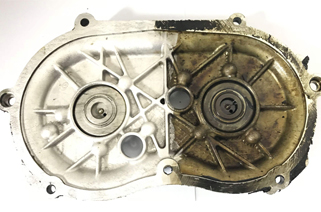
Compared with traditional cleaning methods such as mechanical friction cleaning, chemical corrosion cleaning, liquid solid strong impact cleaning, and high-frequency ultrasonic cleaning, laser cleaning has obvious five advantages:
Environmental protection advantages: Laser cleaning is a "green" cleaning method, without the use of any chemicals or cleaning fluids. The cleaned waste is basically solid powder, small in size, easy to store, recyclable, no photochemical reaction, no Will cause pollution.
Effect advantages: The traditional cleaning method is often contact cleaning, which has mechanical force on the surface of the cleaning object, the surface of the damaged object or the cleaning medium is attached to the surface of the object to be cleaned, and cannot be removed, resulting in secondary pollution. Grinding and non-contact, no thermal effects will not damage the substrate, making these problems solved.
Control advantages: The laser can be transmitted through the optical fiber, cooperate with the robot hand and the robot, and realize the long-distance operation conveniently, and can clean the parts that are difficult to reach by the traditional method. This can ensure the safety of the personnel in some dangerous places.
Convenient advantage: laser cleaning can remove various types of contaminants on the surface of various materials, reaching a degree of cleanliness that cannot be achieved by conventional cleaning. It can also selectively clean contaminants on the surface of the material without damaging the surface of the material.
Cost advantage: laser cleaning speed is fast, high efficiency, save time; although the initial investment of laser cleaning system is high at the current stage, the cleaning system can be used stably for a long time, the operating cost is low, and more importantly, it can be easily automated . It is foreseeable that the cost of the laser cleaning system will be greatly reduced in the future, thereby further reducing the cost of using laser cleaning technology.
The methods of laser cleaning can be divided into the following three categories:
1. Laser Dry Cleaning
Using laser radiation to directly decontaminate, after the laser is absorbed by objects or dirt particles, it generates vibration, which separates the substrate and the pollutants. In the laser dry cleaning, there are two main ways to remove dirt particles: One is the instantaneous thermal expansion of the substrate surface, which generates vibrations to remove the particles adsorbed on the surface. The other is the thermal expansion of the particles themselves, causing the particles to leave the surface of the substrate.
2. Laser wet cleaning
Laser wet cleaning is to uniformly cover the surface of the substrate to be cleaned with a layer of liquid dielectric film, and then use laser radiation to remove stains. According to the absorption of laser light by dielectric film and substrate, wet cleaning can be divided into strong substrate absorption, strong dielectric film absorption and dielectric film substrate absorption. When the strong substrate absorbs, after the substrate absorbs the laser energy, the heat is transferred to the liquid dielectric film, the liquid layer at the interface between the substrate and the liquid is overheated and the liquid layer and the stain are removed together.
3. Laser + inert gas cleaning
At the same time of laser radiation, the surface of the workpiece is blown with inert gas. When the contaminants are peeled from the surface, they are blown away from the surface by the gas, avoiding the contamination and oxidation of the clean surface.